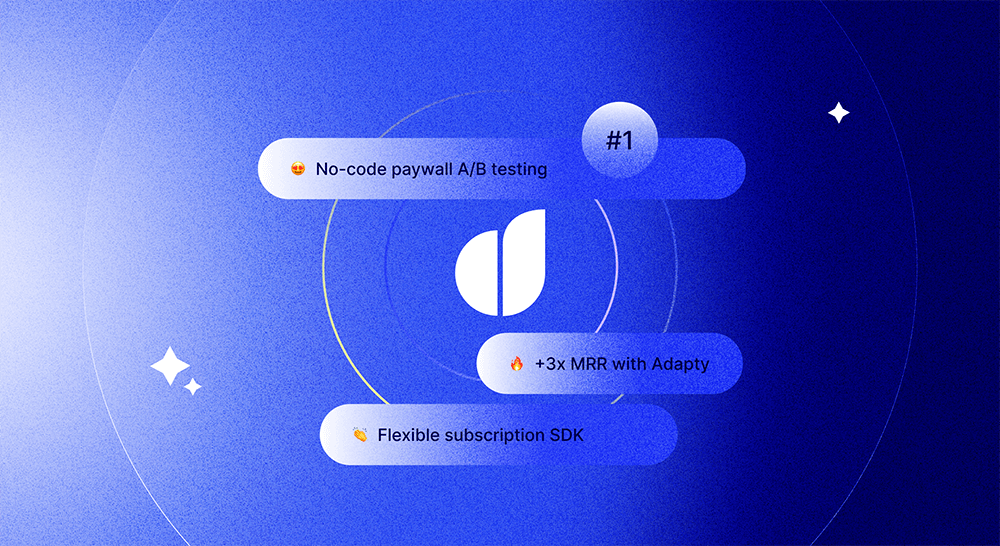
Trends-insights
Analytics
12 min read
July 17, 2024

May 24, 2023
25 min read

Got your app ready to go into the big unknown? Or are you simply in the process of calculating just how much time, money and effort your next big idea will take? Building, launching, and maintaining an app requires a capital investment, something that many app developers don’t have at the start.
Plus, how do you figure out all the customer support hassle? Here’s where financial providers come in! These providers tackle a large chunk of your business ordeals for a fee and can make everything so much easier on your end.
The bad news is that there are way too many options out there and not all of them are good for you. With so many choices, it’s important to choose a financial provider that aligns with your unique business goals and can support your app’s growth in the long run.
From fees and charges to security features, scalability, and customer support, let’s dive deep into all the key factors you need to consider to make an informed decision. So, buckle up and get ready to learn how to choose the perfect financial provider to take your subscription app to the next level!

Before you start researching the best financial service provider, understand your own subscription model. There are 6 main types of subscription models out there, including:
The reason I’m emphasizing these models is that each of them comes with a different set of financial provider requirements. A pay-per-use model might not be well suited to a financial provider with a high transactional fee and a perpetual license model might not profit from a financial provider with high monthly fees!
Always make informed decisions when it comes to selecting a financial provider. In this case, it’s important to have your subscription analytics tell you the story. Then, find a provider that compliments what your app does!
Subscription finance refers to a type of financing used by businesses with a subscription-based revenue model. While these businesses generate recurring revenue through ongoing subscriptions, subscription finance enables them to acquire capital based on the predictable and recurring nature of their revenue streams.
Subscription finance can take several forms, such as:
If you’re wondering, “What is a financial service provider after all?”, you’re not the only one.
An easy financial service provider definition is an app provider that offers services including payment processing, subscription management, revenue and subscription analytics, and other financial tools to help businesses manage their subscription-based revenue models.
These providers often offer software development kits (SDKs) and application programming interfaces (APIs) that enable businesses to integrate their platforms with the financial provider’s services.
This integration allows businesses to manage and process payments, monitor revenue, and analyze user data easily through a single platform. Thanks to all these features, app developers enjoy better overall management, accurate analytics, and a better shot at scalability.
The good news is that there are tons of eager teams out there, waiting to finance your subscription app, no matter what mobile app monetization strategy you’re implementing. But before you shake hands with any of them, it’s crucial to discuss and analyze the cost that comes with that.
Just like any other financer in the world, financial services providers have costs, interest, and charges that you’ll pay at the end of the day. In the end, choosing a financial service provider app depends on competitive rates and transparent pricing structures!
Subscription financing apps may charge a variety of fees and charges, which can vary depending on the provider and the services offered. Some of the most common fees and charges include:
The fees charged by provider apps and financial IT providers can have a significant impact on a business’s revenue and profits. Transaction fees, monthly fees, chargebacks, and other fees can eat into a business’s profit margins, making it harder to generate revenue and grow the business!

For example, if a business processes a high volume of transactions, transaction fees can add up quickly and eat into profits. Similarly, if a financer charges high monthly fees, the cost of using their services may outweigh the revenue generated from subscriptions.
The best way to go about these costs is to sit down with a trusted financial advice provider who can crunch the numbers for you.
If you’re willing to turn your subscription app into a long-run success and make you a cool amount of cash in the meantime, don’t underestimate the importance of finding the right financial provider for your subscription app.
Comparing different fees, interest rates, and charges can make the world’s difference in your revenue and profit. Transaction fees, monthly fees, chargebacks, and other fees can add up quickly and reduce a business’s revenue and profits.
For instance, if your app entertains frequent transactions, a mobile app provider with a low monthly fee is going to be optimal compared to one that offers low transaction charges.
By comparing the fees and charges of different providers, businesses can find a provider that offers the best overall value and meets their specific needs and goals with the help of mobile app metrics!
A saying often goes, “An ounce of prevention is worth a pound of cure.” With subscription models coming through, it can’t be truer. Keeping your app protected from any external threats or fraud isn’t just about protecting your business and revenue; it’s about protecting your customers and their trust in your brand.
Security and fraud protection are critical for subscription-based apps to protect their revenue streams and ensure the safety of their customers’ payment information. If your business relies on recurring revenue streams, any security breach or fraudulence can significantly impact you in the long run.
If you’re unable to do so, you might be looking at significant financial losses, legal liabilities, and damage to the business’s reputation.
How do you combat that? You’ll need to implement robust security measures, such as encryption, multi-factor authentication, and fraud detection systems. Or you can simply sign up with one of the best financial service providers for these services!
Financial data providers for subscription-based apps typically offer a range of security features to help businesses protect their payment and user data. Some of the most common ones include:
With these features, financial solution providers can help subscription-based businesses gain the trust and confidence of users. Not only that, you can safeguard your own business from being attacked by dirty competition. After all, nobody likes getting hacked into!

What’s more is that your security steps can reflect a proactive approach for safeguarding user data and payment details, making it easier for your user base to grow. Existing users will feel at ease using your services while newer ones will be inclined to trust you as well, following a trickle-down effect.
On the other hand, a single security breach can destruct that confidence and growth opportunity. Just imagine a bowling ball knocking down all the pins in one shot; that’s exactly how destructive security breaches can get!
Nobody likes a buggy application that needs constant tech support… wait, how is this relevant to the topic?
Well, did you know that integration and compatibility are the ultimate deciding factors when choosing a financial provider for your subscription app? Firstly, you need to dive into whether the financial service provider’s system is fully compatible and can integrate smoothly with your software.
Seamless integration between the financial provider and your app is critical to ensure a smooth user experience and minimize any disruptions or technical issues. As I said, nobody likes a buggy application that needs constant tech support!
According to Zendesk Customer Experience Trends Report, 70% of consumers spend more time with businesses that offer fluid, personalized, and seamless customer experiences.
Compatibility issues can arise if the financial provider’s system is not fully compatible with the app’s software, resulting in issues such as payment processing errors or delays.
These issues can negatively impact user experience, leading to frustration and a potential loss of customers. Plus, these issues can also result in increased support costs and technical difficulties for the business.
At Adapty, we understand how important seamless integration is for your business’s well-being. With our developer tools, integration services, and subscription calculating analytics, your journey in finding the right financial provider is made easier!
Alright, now you know just how important smooth integration is for your subscription-based app. Now the real question is: how do you make it happen in real-time?
Businesses can take advantage of APIs and developer tools provided by the financial provider. APIs allow for easy communication between the app and the financial provider’s system, enabling real-time payment processing and data exchange.
On the other hand, developer tools such as software development kits (SDKs) and documentation can also help businesses integrate the provider’s system with their app more seamlessly.
Let’s just take our own service as an example! Adapty is a subscription analytics and revenue management platform that provides APIs and developer tools that can help businesses easily integrate with various payment gateways and providers, such as Stripe, Braintree, and PayPal.
Adapty also offers customized integration solutions and support services to help businesses ensure smooth integration and a seamless user experience.
By leveraging Adapty’s integration capabilities, businesses can streamline their payment processing and maximize revenue while providing a seamless and secure user experience for their customers.
2024 subscription benchmarks and insights
Get your free copy of our latest subscription report to stay ahead in 2024.
You can’t finalize your financial provider without considering this aspect of the equation. No matter what business model or type you’re building, growth is always the ultimate goal. Whether it be growing in subscriptions or reaching a larger market share, growth is always there.

With that in mind, the best financial service provider for you is one that can grow with you! How does your financial IT provider deal with increased transactions during a holiday marketing strategy to grow your mobile in-app subscriptions? How does it tackle a 40% annual growth rate?
But let’s roll back and discuss what scalability means to a subscription-based app.
Scalability refers to the ability of an app to grow and handle increased user demand without compromising performance or user experience. For subscription-based apps, scalability is crucial as it allows for future growth and expansion.
Choosing a financial provider that offers flexible plans and features can help ensure that the app can accommodate increased demand and subscriber growth.
According to a survey by Statista, the global subscription market is expected to reach over $478 billion by 2025, which highlights the need for scalability in subscription apps. Having a financial provider that can accommodate this growth and offer customizable plans and features is essential for long-term success.
In addition to flexible plans and features, it’s also important to consider the financial provider’s infrastructure and technology capabilities. The provider should have a robust system that can handle high transaction volumes and ensure security and reliability.
So your financial provider is scalable with your business, offers optimal integration, and protects you from fraud. Great! But you’re not done just yet because you need to tackle customer support. But what difference does it really make?
Good customer support can save you time and money in the long run by quickly resolving any issues or concerns that may arise. It improves the user experience and ultimately determines the span of time a user will spend on your app. This is especially important for subscription apps as any disruptions in the payment or subscription process can lead to customer churn and lost revenue.
According to a survey by PwC, 32% of customers would stop doing business with a company after a single bad experience. Additionally, 54% of customers reported that they have higher customer service expectations than they did just one year ago.
When considering a financial provider, it’s important to look for multiple channels of support, such as phone, email, and chat, as well as 24/7 availability. It’s also important to research the provider’s reputation for customer satisfaction by reading reviews and testimonials from current and former customers.
A financial provider with a strong reputation for customer support can also provide valuable resources and guidance for optimizing your subscription app and improving your overall customer experience.
Are you looking to secure an international market? The interesting thing about subscription businesses is that with the launch of your app, you’re offering it to a global market immediately. With that comes tons of different currencies and languages.
Now if you’re already offering it to the global market, you’ll have to cater to these needs as well. With a global audience, supporting various currencies and countries allows you to accommodate diverse payment preferences and make it easier for customers to transact with your app.
But there are more benefits to making your app diverse with currency support! It enables you to:
By selecting a financial provider with robust currency and country support options, you can expand your subscription-based app’s reach and tap into new markets, paving the way for global success.
Adapty provides support for multiple currencies and payment methods, making it an excellent choice for businesses looking to expand globally.

Last, but not least, we need to talk more about how choosing a financial provider also comes down to the reputation you want in the industry. A reputable financial provider can offer a range of benefits, including reliable payment processing, fraud protection, and excellent customer service.
On the opposite end of the spectrum, partnering with an unreliable or untrustworthy provider can lead to added costs and a tainted reputation.
Researching a financial provider’s reputation is essential to ensure that you are partnering with a reliable and trustworthy provider. When it comes to researching the credibility and reputation of financial data providers, there’s a holy trinity method that never fails!
Here’s the holy trinity of finding a reputable and reliable financial service provider for your business:
Researching these three aspects will reveal valuable insight into a provider’s strengths and weaknesses and help you determine whether they’re a good fit for your business. They can be a good and honest indicator of a provider’s reputation and track record.
For example, a financial provider that has won awards for their payment processing or fraud prevention technology may be a good choice for businesses that prioritize these features.
There’s a reason why successful subscription businesses focus so much on the credibility of their financial solutions provider! After all, a reliable provider can help you:
There you have it! Every factor you need to consider when choosing a financial provider for your subscription-based app. Financial providers are one of the most crucial aspects of your business that can make you an overnight success or take those chances away from you.
So it’s equally essential that you carefully weigh in your options, find out what aligns the best with your business goals and double-check it with analytics and math.
If you want to double your revenue subscription by a service trusted by 2500 leading apps and 537 million users, choose Adapty. Integrate in-app purchases in your app within an hour and watch as your revenue doubles in 3 months with our profitable methods!
Recommended posts

Trends-insights
Analytics
12 min read
July 17, 2024